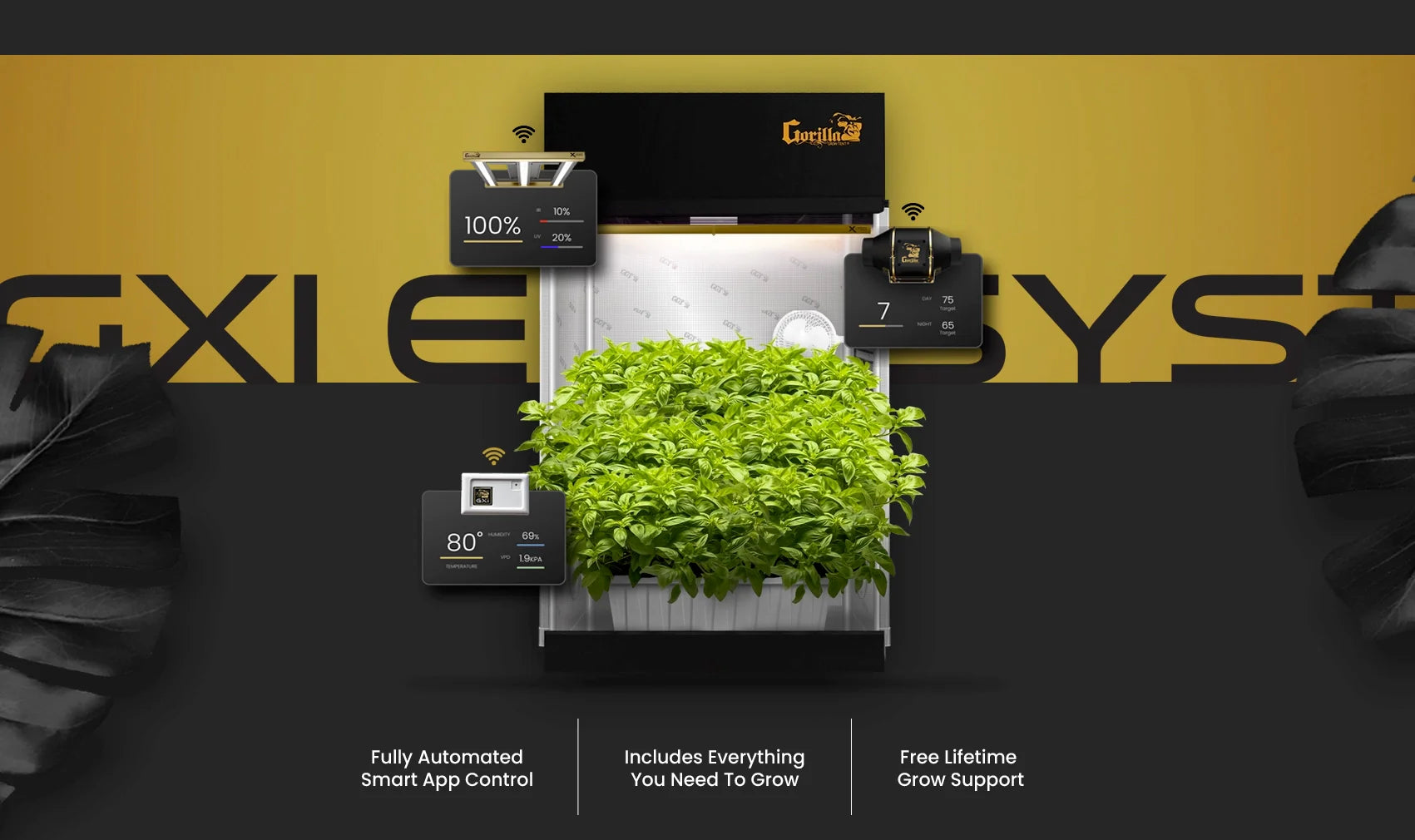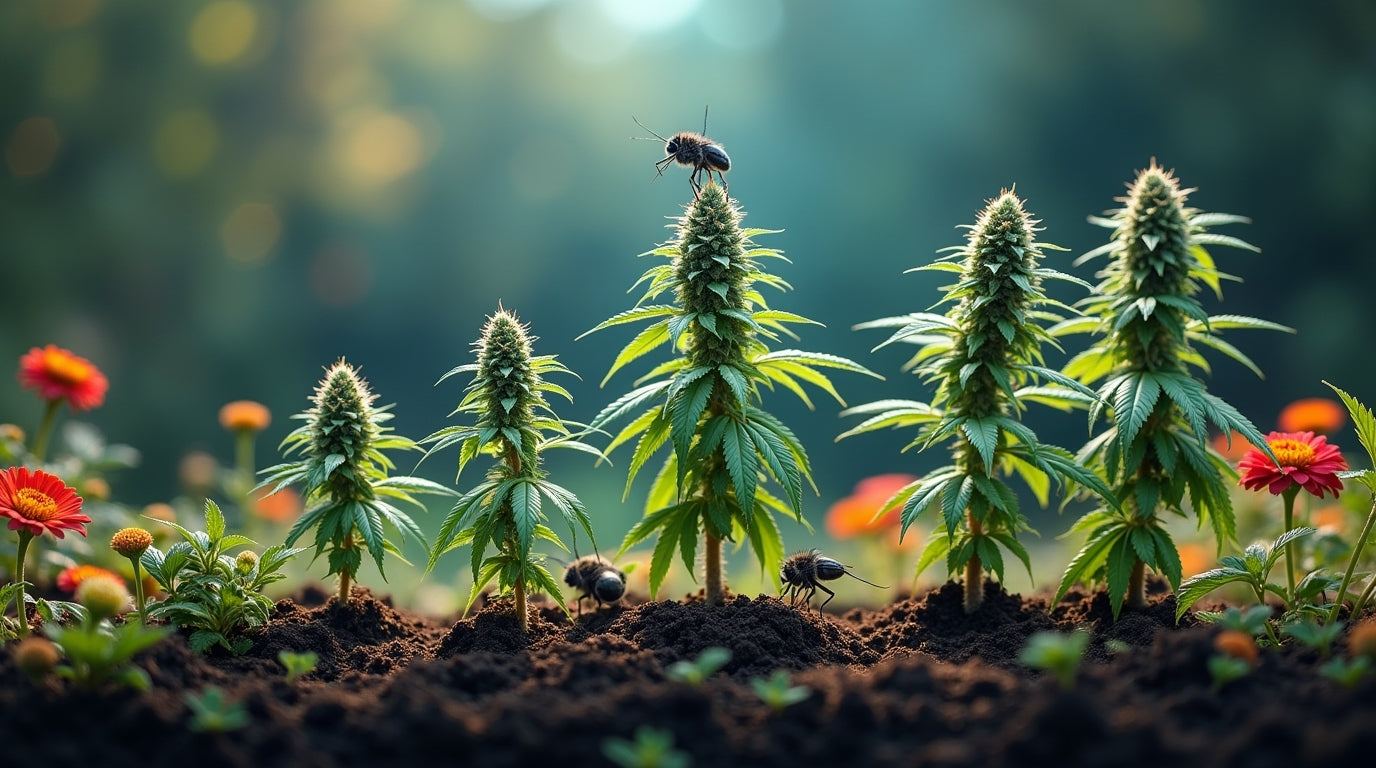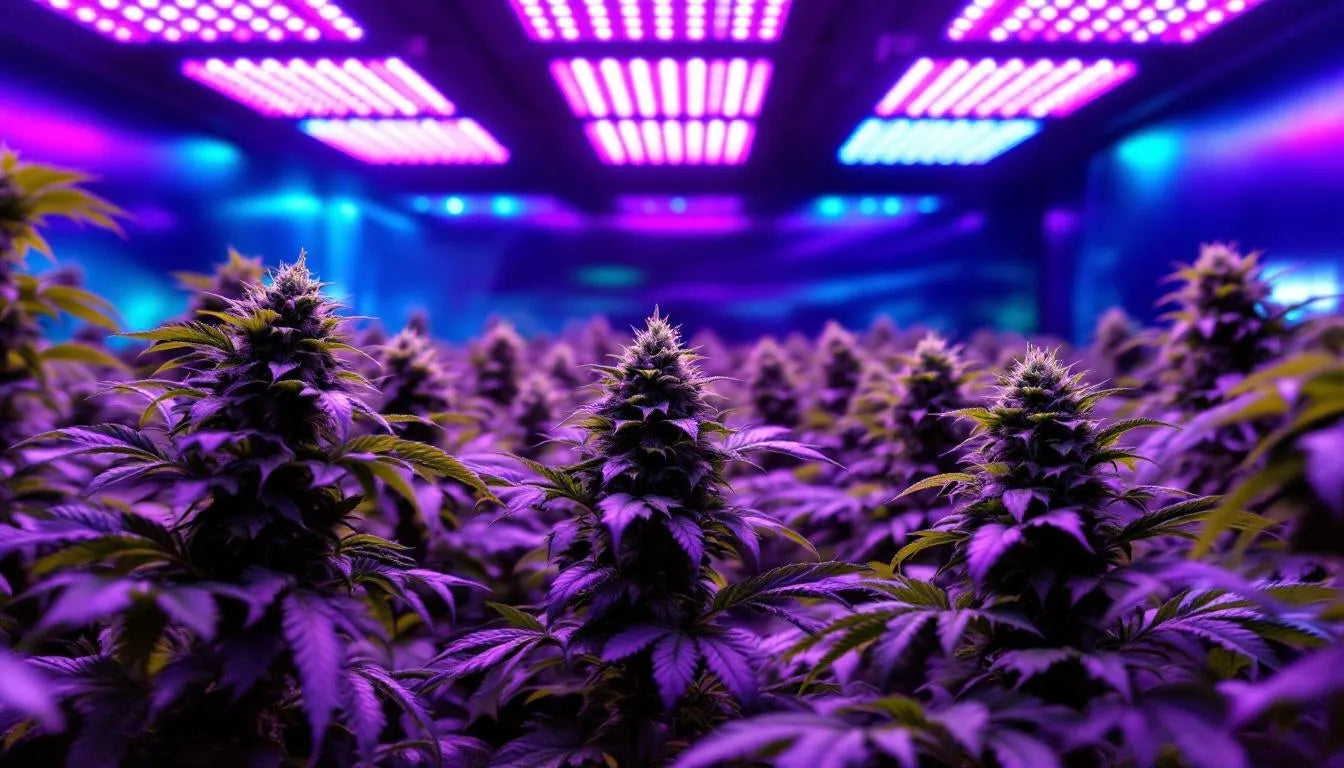
How to Grow Hydroponic Cannabis: Your Complete Guide to Soilless Cultivation
Hydroponic cannabis cultivation represents the pinnacle of modern growing technology, offering faster growth rates, higher yields, and superior quality compared to traditional soil methods. By delivering nutrients directly to the root system through precisely controlled water solutions, hydroponic systems eliminate the variables that limit soil-based grows while providing unprecedented control over every aspect of plant development.
Growing cannabis hydroponically requires mastering nutrient management, pH control, and environmental optimization, but the rewards are substantial. Hydroponic cannabis typically grows 25-50% faster than soil-grown plants, produces denser buds with higher cannabinoid content, and allows for year-round cultivation with consistent results.
This comprehensive guide covers everything you need to know about hydroponic cannabis cultivation, from selecting the right system to advanced optimization techniques. With proper setup and controlled growing environments, you can achieve professional-grade results that surpass traditional growing methods.

Understanding Hydroponic Cannabis Cultivation
Why Choose Hydroponic Cannabis Growing?
Superior Growth Rates:
- Faster vegetative growth: 25-50% faster than soil
- Accelerated flowering: Quicker bud development
- Increased yields: Higher production per square foot
- Consistent results: Predictable growth patterns
Enhanced Quality:
- Higher potency: Improved cannabinoid concentrations
- Denser buds: Superior flower structure
- Better terpene profiles: Enhanced flavor and aroma
- Cleaner product: No soil-borne contaminants
Environmental Benefits:
- Water efficiency: Recirculating systems use less water
- Space optimization: Vertical growing capabilities
- Reduced pesticides: Fewer pest and disease issues
- Year-round cultivation: Independent of seasons
Hydroponic vs. Soil Cannabis Growing
Hydroponic Advantages:
- Precise nutrient control: Exact feeding schedules
- Faster growth cycles: Shorter harvest times
- Higher yields: Increased production capacity
- Consistent quality: Predictable results
Considerations:
- Higher initial investment: Equipment and setup costs
- Technical knowledge required: pH, nutrients, systems
- Power dependency: Requires electricity for pumps/lights
- Active management: Daily monitoring needed
Professional hydroponic growing systems provide the infrastructure needed for successful cannabis cultivation.
Hydroponic System Types for Cannabis
Deep Water Culture (DWC)
How DWC Works:
- Root suspension: Roots hang directly in nutrient solution
- Constant aeration: Air stones provide oxygen
- Continuous feeding: 24/7 nutrient access
- Rapid growth: Fastest growing hydroponic method
DWC Benefits for Cannabis:
- Explosive growth rates: Fastest vegetative development
- Massive root systems: Support large plants
- Simple setup: Fewer components required
- Lower maintenance: Minimal moving parts
DWC Setup Requirements:
- Reservoir: 5-10 gallons per plant minimum
- Air pump and stones: Adequate oxygenation
- Net pots: Support plant structure
- Growing medium: Clay pebbles or rockwool
Learn more about DWC system setup for optimal cannabis cultivation.
Ebb and Flow (Flood and Drain)
System Operation:
- Flood cycle: Nutrient solution floods grow bed
- Drain cycle: Solution returns to reservoir
- Timed intervals: Automated feeding schedule
- Root oxygenation: Air exposure between cycles
Cannabis-Specific Benefits:
- Flexible feeding: Adjust timing for growth stages
- Root health: Excellent oxygen exposure
- Scalability: Easy to expand system size
- Versatile media: Works with various growing mediums
Key Components:
- Grow bed: Holds plants and growing medium
- Reservoir: Stores nutrient solution
- Timer and pump: Controls flood/drain cycles
- Overflow fitting: Prevents overflooding
Ebb and flow systems offer excellent control over cannabis feeding schedules.
Nutrient Film Technique (NFT)
NFT Principles:
- Thin film flow: Continuous nutrient film over roots
- Sloped channels: Gravity-fed nutrient flow
- Partial root exposure: Roots access both nutrients and air
- Recirculating system: Efficient nutrient use
Cannabis Applications:
- Vegetative growth: Excellent for early stages
- Space efficiency: Maximize growing area
- Water conservation: Minimal waste
- Continuous feeding: Steady nutrient supply
Drip Systems
Drip System Features:
- Targeted delivery: Nutrients drip directly to root zone
- Adjustable flow: Control feeding rates
- Scalable design: Easy to expand
- Medium flexibility: Works with various substrates
Cannabis Growing Advantages:
- Precise control: Individual plant feeding
- Reduced waste: Minimal runoff
- Automation potential: Timer-controlled feeding
- Versatile setup: Adapt to different plant sizes
Cannabis Nutrition in Hydroponic Systems
Understanding Cannabis Nutrient Needs
Primary Macronutrients:
- Nitrogen (N): Essential for vegetative growth and leaf development
- Phosphorus (P): Critical for root development and flowering
- Potassium (K): Supports overall plant health and resin production
Secondary Nutrients:
- Calcium (Ca): Strengthens cell walls and structure
- Magnesium (Mg): Central to chlorophyll production
- Sulfur (S): Important for protein synthesis and terpenes
Micronutrients:
- Iron (Fe): Essential for chlorophyll and enzyme function
- Zinc (Zn): Supports hormone production
- Manganese (Mn): Activates enzymes and supports photosynthesis
Growth Stage Nutrition
Vegetative Stage (Weeks 4-8):
- High nitrogen: 150-200 PPM for leaf development
- Moderate phosphorus: 50-100 PPM for root growth
- Balanced potassium: 100-150 PPM for overall health
- Full micronutrients: Support rapid growth
Flowering Stage (Weeks 9-20):
- Reduced nitrogen: 50-100 PPM to prevent leafy growth
- Increased phosphorus: 100-200 PPM for bud development
- High potassium: 200-300 PPM for resin production
- Calcium/magnesium: Prevent deficiencies during heavy feeding
Late Flowering (Final 2-3 weeks):
- Minimal nitrogen: 0-50 PPM for proper maturation
- Maintained phosphorus: Support final bud development
- Reduced overall feeding: Prepare for harvest flush
Nutrient Solution Management
Concentration Monitoring:
- EC/TDS meters: Measure nutrient concentration
- PPM targets: Adjust based on growth stage
- Gradual increases: Avoid shocking plants
- Strain-specific needs: Some varieties require more/less
**Professional nutrient systems like General Hydroponics nutrients provide comprehensive feeding programs for cannabis.
pH Control and Water Quality
pH Management for Cannabis
Optimal pH Ranges:
- Hydroponic systems: 5.5-6.5 for nutrient uptake
- Vegetative stage: 5.8-6.2 for nitrogen absorption
- Flowering stage: 6.0-6.5 for phosphorus/potassium
- pH fluctuation: Daily monitoring and adjustment
pH Control Methods:
- pH Up solution: Raises pH when too acidic
- pH Down solution: Lowers pH when too alkaline
- pH buffers: Stabilize pH levels
- Automatic dosing: Maintains consistent levels
pH control kits provide everything needed for precise pH management.
Water Quality Considerations
Source Water Testing:
- Starting pH: Baseline for adjustments
- Mineral content: Affects nutrient calculations
- Chlorine levels: Can damage beneficial bacteria
- Temperature: Affects dissolved oxygen levels
Water Treatment:
- Reverse osmosis: Creates pure water baseline
- Dechlorination: Remove harmful chemicals
- Temperature control: Maintain 65-75°F
- Oxygenation: Ensure adequate dissolved oxygen
Common pH Problems
pH Drift:
- Causes: Nutrient uptake, bacterial action, temperature
- Solutions: Regular monitoring, buffer solutions
- Prevention: Stable environment, quality nutrients
Nutrient Lockout:
- Symptoms: Deficiency signs despite adequate nutrients
- Causes: Incorrect pH preventing uptake
- Treatment: Flush system, correct pH, resume feeding
Environmental Control for Hydroponic Cannabis
Temperature Management
Optimal Temperature Ranges:
- Air temperature: 70-80°F during day, 60-70°F at night
- Nutrient solution: 65-75°F for healthy roots
- Root zone: Slightly cooler than air temperature
- Consistency: Avoid temperature swings
Temperature Control Methods:
- Reservoir chillers: Cool nutrient solutions
- Heating mats: Warm root zones if needed
- Exhaust fans: Remove heat from grow space
- Insulation: Maintain stable temperatures
Humidity Control
Humidity Requirements:
- Vegetative stage: 50-70% RH for healthy growth
- Flowering stage: 40-50% RH to prevent mold
- Late flowering: 30-40% RH for resin production
- Air circulation: Prevent stagnant air pockets
Humidity Management:
- Dehumidifiers: Remove excess moisture
- Exhaust ventilation: Remove humid air
- Air circulation: Promote transpiration
- Reservoir covers: Prevent evaporation
Environmental control systems help maintain optimal conditions throughout the grow cycle.
Air Circulation and Oxygenation
Root Oxygenation:
- Air stones: Provide dissolved oxygen
- Venturi valves: Inject air into nutrient lines
- Reservoir agitation: Maintain oxygen levels
- Temperature control: Cooler water holds more oxygen
Canopy Airflow:
- Oscillating fans: Strengthen stems and prevent mold
- Exhaust systems: Remove stale air
- Carbon filters: Control odors
- Fresh air intake: Provide CO2 for photosynthesis

Setting Up Your Hydroponic Cannabis System
Planning Your Setup
Space Requirements:
- Growing area: 2-4 square feet per plant
- Reservoir access: Easy maintenance and monitoring
- Equipment space: Pumps, chillers, controllers
- Future expansion: Room for system growth
System Selection:
- Beginner-friendly: DWC for simplicity
- Intermediate: Ebb and flow for control
- Advanced: NFT for efficiency
- Commercial: Drip systems for scalability
Essential Equipment Checklist
Hydroponic System:
- Growing containers: Net pots, grow beds, reservoirs
- Pumps and timers: Circulation and feeding control
- Air pumps and stones: Root oxygenation
- Tubing and fittings: System connections
Monitoring Equipment:
- pH meter: Daily solution testing
- EC/TDS meter: Nutrient concentration monitoring
- Thermometer: Temperature tracking
- Hygrometer: Humidity measurement
Environmental Control:
- Grow tent: Controlled environment
- LED grow lights: Full spectrum lighting
- Ventilation system: Air exchange and cooling
- Carbon filter: Odor control
Complete hydroponic grow systems include all necessary components for successful cannabis cultivation.
System Assembly
Step-by-Step Setup:
- Prepare grow space: Install tent, lighting, ventilation
- Assemble hydroponic system: Connect components according to instructions
- Install monitoring equipment: pH/EC meters, thermometers
- Fill reservoir: Add water and initial nutrients
- Test system: Check pumps, timers, and circulation
- Adjust pH: Bring solution to optimal range
- Plant seedlings: Transfer into growing medium
Initial System Cycling
Pre-Plant Preparation:
- 24-48 hour circulation: Test all components
- pH stabilization: Allow system to equilibrate
- Leak testing: Check all connections
- Nutrient verification: Confirm proper concentrations
Advanced Hydroponic Cannabis Techniques
Training and Plant Management
Hydroponic Training Advantages:
- Faster recovery: Quicker healing from training stress
- Precise nutrition: Support aggressive training
- Root access: Easy monitoring of root health
- Consistent growth: Predictable response to training
Recommended Training Methods:
- LST (Low Stress Training): Gentle bending for even canopy
- SCROG (Screen of Green): Horizontal training through screens
- Topping/FIMing: Increase cola production
- Defoliation: Improve light penetration
Nutrient Optimization
Advanced Feeding Strategies:
- Nutrient cycling: Alternate feeding schedules
- Bloom boosters: Enhance flowering nutrition
- Beneficial additives: Enzymes, vitamins, amino acids
- Strain-specific feeding: Adjust for individual varieties
Common Nutrient Issues:
- Nutrient burn: Overfeeding symptoms and solutions
- Deficiencies: Identifying and correcting shortages
- Lockout: pH-related uptake problems
- Toxicity: Managing excess nutrients
System Optimization
Performance Enhancement:
- Reservoir management: Regular water changes
- Root health: Monitoring and maintenance
- System cleaning: Preventing buildup and contamination
- Automation: Timers, dosing systems, monitoring
Troubleshooting Common Issues:
- Algae growth: Light exclusion and prevention
- Root rot: Oxygenation and temperature control
- pH drift: Stabilization techniques
- Pump failures: Backup systems and maintenance
Harvesting and Post-Harvest
Harvest Timing
Hydroponic Harvest Indicators:
- Trichome development: 70-80% cloudy for peak potency
- Pistil color: 70-90% orange/brown
- Fade progression: Natural leaf yellowing
- Resin production: Maximum trichome development
Pre-Harvest Preparation:
- Flush period: 7-14 days with plain water
- Reservoir cleaning: Remove nutrient buildup
- Environmental adjustment: Lower humidity for final weeks
- Harvest planning: Prepare drying and curing space
Drying and Curing
Hydroponic Cannabis Drying:
- Initial moisture: Higher water content than soil-grown
- Slower drying: Prevent rapid moisture loss
- Environmental control: 60-70°F, 45-55% RH
- Air circulation: Gentle airflow around buds
Curing Considerations:
- Jar conditioning: Gradual moisture equalization
- Burping schedule: Release excess moisture
- Long-term storage: Maintain optimal conditions
- Quality monitoring: Check for mold or over-drying
FAQ Section
Q: Is hydroponic cannabis more potent than soil-grown? A: Hydroponic cannabis can be more potent because precise nutrient control allows plants to maximize cannabinoid production. However, genetics and growing skill are more important factors than the growing medium itself.
Q: How often should I change the nutrient solution? A: Change nutrient solutions every 1-2 weeks during vegetative growth and weekly during flowering. More frequent changes may be needed in smaller reservoirs or with fast-growing plants.
Q: What's the best hydroponic system for beginners? A: Deep Water Culture (DWC) is ideal for beginners because it's simple, inexpensive, and provides excellent results. It has fewer components and is easier to troubleshoot than more complex systems.
Q: How do I prevent root rot in hydroponic cannabis? A: Maintain proper water temperature (65-75°F), ensure adequate oxygenation with air stones, keep reservoirs clean, and maintain proper pH levels. Good circulation and regular water changes also help prevent root problems.
Q: Can I grow hydroponic cannabis organically? A: Yes, you can use organic nutrients in hydroponic systems, though it's more challenging than synthetic nutrients. Organic hydroponic nutrients require careful pH management and may need beneficial bacteria to break down organic matter.
Featured Snippet Summary
How to grow hydroponic cannabis: Set up DWC or ebb and flow system, maintain pH 5.5-6.5, use cannabis-specific nutrients (150-200 PPM nitrogen vegetative, 100-200 PPM phosphorus flowering), keep nutrient solution 65-75°F, provide 18/6 light vegetative and 12/12 flowering, change solution weekly, and harvest when trichomes are 70-80% cloudy.
Transform Your Cannabis Growing with Professional Hydroponic Systems
Hydroponic cannabis cultivation represents the future of indoor growing, offering unmatched control, speed, and quality compared to traditional methods. However, success requires more than just a hydroponic system—it demands a controlled environment that maintains perfect conditions throughout the entire growing cycle.
Gorilla Grow Tents provide the environmental foundation essential for hydroponic cannabis success. With precise temperature control, humidity management, and superior ventilation systems, you can maintain the stable conditions that hydroponic systems require while maximizing the benefits of soilless cultivation.
The advanced environmental control possible with professional grow tents ensures your nutrient solutions stay at optimal temperatures, pH remains stable, and plants receive consistent environmental conditions that hydroponic systems thrive in.
Whether you're starting with a compact DWC setup or planning a large-scale hydroponic operation, having the right environmental control eliminates the variables that can disrupt hydroponic growing while maximizing the speed and quality advantages of soilless cultivation.
Ready to experience the superior results of hydroponic cannabis cultivation? Explore our complete hydroponic growing systems and discover why serious growers choose controlled environments for their most advanced cultivation techniques.
Take your hydroponic growing to the next level with our guides on optimizing grow room environments and mastering environmental control for maximum hydroponic success.

Lena Myles
I'm a mushroom enthusiast and home cook based in Oregon. I'm passionate about foraging and creating fungi-focused recipes, especially delicious, plant-based dishes using gourmet mushrooms like trumpet, shiitake, and oyster. When I’m not in the kitchen, you’ll usually find me wandering the woods in search of new wild flavors.


